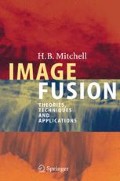Abstract
The subject of this chapter is a collection of miscellaneous effects which affect the brightness and color perception in a input image or in a input video. For the sake of concreteness, we shall concentrate on three important effects: Vignetting, automatic gain control and white balance. Vignetting we define as a positiondependent loss of brightness in an input image. This loss of brightness manifests itself as a gradual fading-out of an image at points near the image periphery.White balancing we define as as the adjustment of an input image to recover its true coloration. Automatic gain control effects refers to the temporal variation of the camera settings as a result of automatic gain control mechanism.
Access this chapter
Tax calculation will be finalised at checkout
Purchases are for personal use only
Preview
Unable to display preview. Download preview PDF.
References
Bianco, S., Gasparini, F., Schettini, R.: A consensus based framework for illuminant chromaticity estimation. J. Elect. Imag. 17, 023017 (2008)
Kim, S.J., Pollefeys, M.: Robust radiometric calibration and vignetting correction. IEEE Trans. Patt. Anal. Mach. Intell. 30, 562–576 (2008)
Lam, E.Y.: Combining gray world and retinex theory for automatic white balance in digital photography. In: Proc. 9th Int. Symp. Consumer Elect. (2005)
Litvinov, A., Schechner, Y.Y.: Radiometric framework for image mosaicking. J. Opt. Soc. Am. 22A, 839–848 (2005)
Lukac, R.: Refined automatic white balancing. Elect. Lett. 43, 445–446 (2007)
Lukac, R.: New framework for automatic white balancing of digital camera images. Signal Process. 88, 582–593 (2008)
Mann, S.: Comparametric equations. IEEE Trans. Image Proc. 9(9), 1389–1406 (2000)
Yalcin, H., Collins, R., Hebert, M.: Background estimation under rapid gain change in thermal imagery. In: Proc. IEEE Workshop on Object tracking and classification in and beyond the visible spectrum, pp. 1142–1149 (2005)
Yalcin, H., Collins, R., Black, M., Hebert, M.: Background estimation under rapid gain change in thermal imagery. Comp. Vis. Image Understand. 106, 148–161 (2007)
Yu, W.: Practical anti-vignetting methods for digital cameras. IEEE Trans. Consumer Elect. 50, 975–983 (2004)
Rights and permissions
Copyright information
© 2010 Springer-Verlag Berlin Heidelberg
About this chapter
Cite this chapter
Mitchell, H.B. (2010). Vignetting, White Balancing and Automatic Gain Control Effects. In: Image Fusion. Springer, Berlin, Heidelberg. https://doi.org/10.1007/978-3-642-11216-4_15
Download citation
DOI: https://doi.org/10.1007/978-3-642-11216-4_15
Publisher Name: Springer, Berlin, Heidelberg
Print ISBN: 978-3-642-11215-7
Online ISBN: 978-3-642-11216-4
eBook Packages: EngineeringEngineering (R0)

